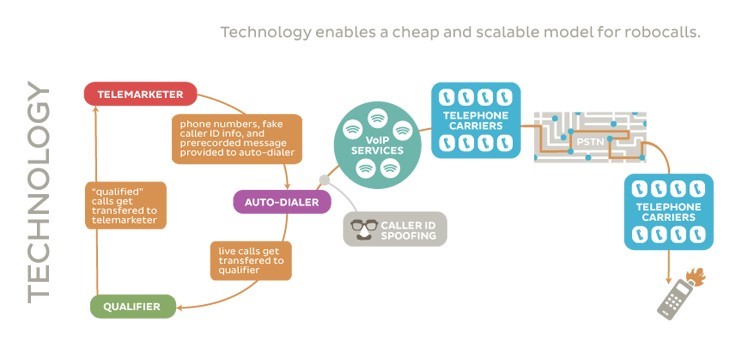“A pestilence.”
“Deserving of a fate worse than death.”
“A curse on all their houses.”
Those were some of the comments regarding last week’s article, about the scammers responsible for the epidemic of scam phone calls. To recap:
- By mid-2019, half of all U.S. phone calls will be scams. Ninety percent of those calls will appear to come from local numbers.
- The government is more concerned with deregulating the telecoms sector than with addressing the problem. And with our monopoly-protected telecoms, providers feel little market pressure to address it.
As with so many other problems in today’s world, this means the solution is entirely up to you — and to people like me, whose job it is to help you find and implement it.
So, as promised last week, here are 10 ways you can fight back against the “scum of the earth” … phone scammers.
Technology Always Has a Dark Side
According to the Federal Trade Commission, scammers extracted $1 billion from Americans last year … and 70% of the time, fraud began with a phone call.
These days, in addition to your landline or mobile phone, you can also initiate a call from an app such as Skype, WhatsApp, Facebook Messenger, amongst others. These methods use “voice over internet protocol,” or VoIP.
Unlike traditional networks, VoIP calls are difficult to detect. That’s because they are blended in with all the other internet traffic flowing around the globe.
Telemarketers use sophisticated VoIP programs. They autodial millions of numbers a minute. They usually dial randomly, using fake caller ID information. Occasionally they dial lists of actual numbers hacked from poorly protected business databases.
Ultimately, these VoIP calls are routed through conventional mobile or landline networks. But because they originated using VoIP, it’s difficult (but not impossible) to identify the actual caller, including their real phone number and physical location.
If a scam VoIP call is answered, it is routed to a live telemarketer or to a phone tree, and the scam begins:

Now, most scam calls using VoIP aren’t encrypted, since this would increase the cost and complexity for the scammer.
The U.S. government’s spy agencies have the technology to trace unencrypted VoIP calls. The same technology is available to U.S. telecoms companies. But as I explained last week, they are reluctant to use it because it would require investment and ongoing expense on their part.
That’s why the problem is yours to solve.
How to Defend Yourself from Phone Scammers
There are three broad ways to combat scam calls. The first is technological.
As I mentioned last week, I’ve been using a service called Nomorobo for a couple of years now. It maintains a list of known scam callers and blocks them on both landline and mobile phones.
Other apps do the same thing, including TrueCaller, RoboKiller, Hiya, Mr. Number, CallBlocker, TrapCall and YouMail (which I have also used for about a year).
Most major phone companies offer similar blockers, although they are far less effective.
Unfortunately, these apps suffer from a fatal flaw. They can block calls only from numbers reported by their users.
But since scam callers can switch fake caller IDs in milliseconds, there is no way these apps can possibly keep up.
To make matters worse, many of these caller IDs belong to legitimate customers, whose calls are also blocked by these apps.
Change Your Phone Habits
The second approach involves changing the way you use your phone.
Here are 10 ways to defeat phone scammers (admittedly, some of these do involve technology):
- Do not register on the Federal Trade Commission’s Do Not Call List. Scammers will never abide by the list, and there is a suspicion in tech circles that the list has been hacked by scammers.
- Never give your actual phone number to companies who ask for it, unless it is absolutely necessary. You know how cashiers will often ask you for your email and phone number when you buy something at a store? Or when hotel employees ask you for a number where they can contact you during your stay? Don’t do it. Given the appalling lack of data security in the U.S. corporate sector, that number is highly likely to end up stolen by a scammer.
- Create a disposable second number to give out instead. VoIP applications like Skype have long allowed subscribers to create a telephone number that rings only on that app. If the number is compromised, you can simply change it. The same technique works on other platforms, such as Google Voice, Sideline and Line2. Also, these apps are VoIP-based, and the companies that provide them have incentive to invest in identifying and blocking scam VoIP calls.
- Do not answer calls without caller ID information. This includes calls marked “Private Number,” “Invalid Caller ID,” “Anonymous Caller” and so on. If it’s a legitimate call, let the caller leave a message. The flipside of this, of course, is that you should not set your own phone to hide your caller ID. People like me will ignore your calls.
- Do not answer calls from unknown numbers. This is the most unfortunate aspect of the scam call pestilence, but there is no way around it. Again, if it’s a legitimate call, the caller will leave a message and you can return it.
- Save important contact numbers on your phone’s address book so that the name will appear when you’re called. Of course, there is a possibility that a scammer might try to call you from a saved number, but the likelihood is miniscule (for now).
- Buy a landline phone that prevents calls from unsaved numbers from ringing. I helped one of my relatives set up such a system. It’s a bit of a pain, since you must save important numbers into the system up front, or else they won’t ring. I helped my relative get around this by telling her to keep the phone with her for a couple of weeks, so she could see the caller ID of incoming calls. She could choose to answer them and add the number to the system’s address book.
- Educate yourself about common scams. Scams like the Social Security con, I mentioned last week, rely on one thing that rarely happens in real life. If there is really a problem with your Social Security, IRS or other government agency, those institutions would send you a letter asking you to contact them. They would never call you and ask to start solving a problem on the phone. The same goes for scams involving infected computer software. Microsoft would never call anyone to inform them of a software issue. All such calls are scams.
- Adopt one of the aforementioned apps. Nomorobo, TrueCaller, RoboKiller, Hiya, Mr. Number, CallBlocker, TrapCall or YouMail.
- Make an Issue of It. Earlier I said there were 10 ways to address the funds scam pestilence. The final way is to make an issue of this problem. As I’ve stressed repeatedly, effective blocking technologies do exist that could dramatically limit the amount of scam robocalls infesting U.S. phone networks.
The only thing that prevents it is our monopolistic telecoms sector. Big Telecoms know people aren’t going to give up their phones, even if 90% of their calls are scams. What other options do they have? It’s not like they have a wide choice of service providers.
When systemic problems like this happen, it’s up to our representatives in Congress to get busy and do something about it … like passing laws forcing telecoms companies to address the issue.
After all, an effective national barrier to scam robocalls is a wall every American would support.
Kind regards,

Ted Bauman
Editor, The Bauman Letter








